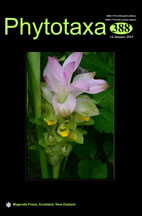Abstract
Ophiopogon Ker Gawler (1808: t. 1063) and Peliosanthes Andrews (1810: t. 605) are widely distributed over temperate to tropical regions of east, southeast and south Asia (Jessop 1976, 1979). Neolourya Léopold Rodriguez (1934a: 96), with two species, was described from Vietnam, but was later included in Peliosanthes by Tanaka (2004a). Sharing such unique features as reduced compound racemes, carpels (or ovary walls) rupturing in early stages of fruiting, and exposed seeds with blue fleshy testa that look like fruits (berries), Ophiopogon and Peliosanthes (including Neolourya) are regarded as closely allied, and classified, together with Liriope Loureiro (1790: 200), in the tribe Ophiopogoneae Endlicher (1836: 156) (Dahlgren et al. 1985).

